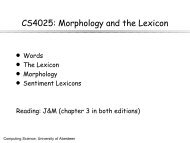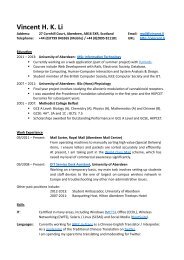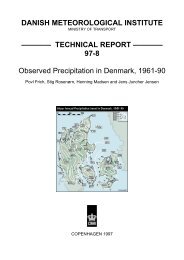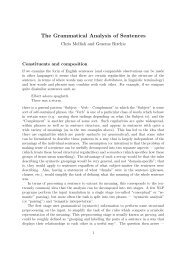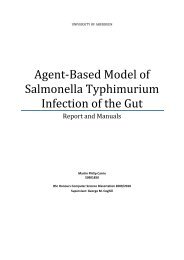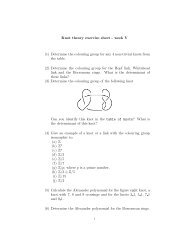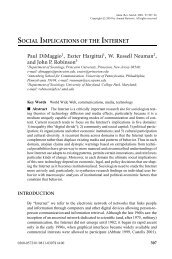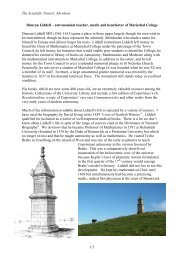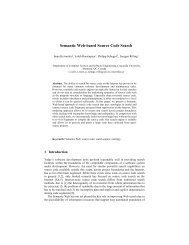ELF - Homepages | The University of Aberdeen
ELF - Homepages | The University of Aberdeen
ELF - Homepages | The University of Aberdeen
You also want an ePaper? Increase the reach of your titles
YUMPU automatically turns print PDFs into web optimized ePapers that Google loves.
26<br />
Excluded Letter Fluency Test (<strong>ELF</strong>):<br />
Norms andTest-Retest Reliability Data<br />
for Healthy Young Adults<br />
E. Arthur Shores<br />
M a q u a ri e U n ive rsitY, Au stra I i a<br />
Jane R. Carstairs<br />
lJniversity <strong>of</strong> Wolverhampton, United Kingdom<br />
John R. Crawford<br />
university <strong>of</strong> <strong>Aberdeen</strong>, United Kingdom<br />
I\ lormative and reliability data for the Excluded Letter Fluency [<strong>ELF</strong>) Test are<br />
l\orovided. A stratified random sample <strong>of</strong> 399 healthy young adults aged 1B to<br />
34 years from Sydney, Australia, completed the <strong>ELF</strong> Test as well as a full-length<br />
WAIS-R, as part <strong>of</strong> a larger battery <strong>of</strong> tests. After a 1-year interual 99 <strong>of</strong> these individuals<br />
were retested on the same forms <strong>of</strong> the tests. <strong>The</strong> influence <strong>of</strong> age, sex<br />
and education was investigated on the <strong>ELF</strong> and only education was found to have<br />
a significant overall effect on the total scores. However, gender was found to have<br />
an effect on the error scores, with males making more rule-breaks than females.<br />
Tables are provided for converting <strong>ELF</strong> raw scores, corrected for years <strong>of</strong> education,<br />
to standard scores with 900/o and 950/o confidence intervals for both test and<br />
retest purposes. A table for calculating the base rate <strong>of</strong> errors, for males and for<br />
females, on the <strong>ELF</strong> is also provided.<br />
Normative data sets exist on numerous fbrms <strong>of</strong><br />
verbal fluency tests (Lezak, Howieson' & Loring,<br />
2004). <strong>The</strong> concept <strong>of</strong> measuring verbal fluency<br />
can be traced back to the Thurstone Word<br />
Fluency Test, which required a written response<br />
(Thurstone, 1938) and an oral form, which has<br />
come to be known as the FAS Test or Controlled<br />
Oral Word Association Test (Bechtoldt, Benton.<br />
& Fogel, 1962; Benton, 1967; Spreen & Benton,<br />
1969). Most forms <strong>of</strong> the verbal fluency task have<br />
requirecl patients to provide, in a given period <strong>of</strong><br />
time, as many words as they can think <strong>of</strong> beginning<br />
with a particular letter (initial-letter fluency)<br />
or belonging to a particular category such as animals<br />
or fiuits (semantic fluency).<br />
<strong>The</strong> popularity <strong>of</strong> initial-letter fluency tests in<br />
clinical neuropsychology may be accounted for by<br />
the sensitivity <strong>of</strong> such tests to linguistic impairment,<br />
Au s t ro I i a. E - nuti I : a s h o re's @ 1t s v-. nul. e d Lt. o tr<br />
parricularly following dominant frontal system or<br />
executive clystunction (e.g., Elfgren, Ryding, &<br />
Passant, 1996). It has been argued that semantic fluency<br />
tasks are relatively insensitive to executive<br />
dysfunction because everyday word retrieval is conducted<br />
on the basis <strong>of</strong> semantics and this is therefbre<br />
a relatively non-effortful task. In contrast,<br />
initial-letter fluency requires a novel retrieval strategy<br />
and imposes a heavier rnonitoring demand to<br />
prevent production <strong>of</strong> illegitimate, semantically<br />
related words. Recently. however, a more demanding<br />
form <strong>of</strong> verbal fluency, excluded letter fluency,<br />
has been demonstrated to be sensitive to cognitive<br />
impairment in patients with traumatic brain injuries<br />
(Crawford, Wright, & Rate, 1995). <strong>The</strong> excluded<br />
letter fluency test requires patients to generate as<br />
many words as they can that do not contain certain<br />
letters. In the Crawfbrd et al. study 24 patients and<br />
',Departtttetttt|.Ps,-choklg\.,MttcquclrieIJniversit.,-,Syclnet,NSw2109'<br />
BRAIN IMPAIRMENT<br />
voLUME 7 NUMBER I MAY 2006 pP.26-32<br />
-
;tem or<br />
ing, &<br />
rtic flu-<br />
.ecutive<br />
. is cons<br />
there-<br />
)ontrast,<br />
al stratnand<br />
to<br />
rntically<br />
lemandfluency,<br />
,ognitive<br />
L injuries<br />
:xcluded<br />
Ierate as<br />
n certain<br />
ients and<br />
sw 2109,<br />
PAIRMENT<br />
06 pp.26-32<br />
<strong>ELF</strong> NORMS<br />
24 matched control participants were required to between these measures' clinicians could then use<br />
generate words that did not contain the letters A' IQ to predict excluded letter fluency performances'<br />
&ren P, then l. This task therefore is further removed <strong>The</strong> present study reports normative data for<br />
from routine retrieval and places heavier demands an excluded letter fluency test derived from a rel-<br />
on the monitoring process. One <strong>of</strong> the hypotheses atively large group <strong>of</strong> healthy young adults, who<br />
tested in the Crawforcl et al. study was that produc- also had been administered a full-length WAIS-R'<br />
tion scores on the dift'erent fluency tasks would <strong>The</strong>se were participants in the Macquarie<br />
2a<br />
E. ARTHUR SHORES, JANE R. CARSTAIRS AND JOHN R. CRAWFORD<br />
Measures<br />
<strong>The</strong> following tests were given as part <strong>of</strong> the larger<br />
MUNNS neuropsychological test battery'<br />
WAIS-R (Wechsler, 1981). <strong>The</strong> full WAIS-R was<br />
administered and scored using the procedures in<br />
Wechsler (1981) and de Lemos (1981).<br />
E LF ( C rawford, Wright, & Bate, I 99 5 ). Instructions<br />
for administering and scoring the <strong>ELF</strong> are provided<br />
in Appendix A.<br />
Derivation <strong>of</strong> DemograPhicallY<br />
Adjusted Norms<br />
To investigate the inf'luence <strong>of</strong> demographic variables<br />
on the raw scores <strong>of</strong> the <strong>ELF</strong> a three-way<br />
ANOVA was perfotmed with age, sex and education<br />
as the independent variables. Participants were<br />
divided into two age groups (18 to 25, n = 201 and<br />
26 to 34, n = 198). Three levels <strong>of</strong> education were<br />
used, less than 12 years (n - 9l), 12 years (rl = 9l)<br />
and greater than 12 years (n = 217). A significant<br />
overall effect was found only for education<br />
(F = I1.18, df - 2, p < .001; eta squared = .055).<br />
Following the method used by Ruff et al., correction<br />
factors which adjust the means for each education<br />
group to a value equivalent to the overall mean were<br />
calculated. <strong>The</strong> means and standard deviations <strong>of</strong> the<br />
raw scores obtained on the <strong>ELF</strong> by education group'<br />
as well as the correction factors are provided in<br />
Table l.<br />
Cambridge Contextual Reading Test (CCRT;<br />
Beardsall & Huppeft, 1994). Beardsall and Huppert<br />
investigated the extent to which putting NART words<br />
into sentences facilitated correct pronunciation. <strong>The</strong>y<br />
found that both normal and demented subjects substantially<br />
improved their perforrnance when the<br />
words were seen in context. In the MUNNS the<br />
CCKI was replaced with the Australian Contextual<br />
NART Reading Test part way through the study as<br />
this latter test was considered to be more appropriate<br />
in an Australian context. One hundred and thirty-five<br />
participants were tested on the CCRT'<br />
Australian Contextual NART Reading Test<br />
(ACNRT). A contextual version <strong>of</strong> the Australian<br />
NART (AUSNART; Hennessy & Mackenzie,<br />
1995) was developed for use in the MUNNS study.<br />
<strong>The</strong> original AUSNART words were put into context<br />
in the fbrm <strong>of</strong> simple, meaningful sentences.<br />
<strong>The</strong>se sentences are available in the Appendix to<br />
the article by Lucas, Carstairs and Shores (2003)'<br />
Two hundred and forty-four participants were<br />
assessed on the ACNRT.<br />
Results<br />
Psychometric Properties <strong>of</strong> <strong>ELF</strong><br />
<strong>The</strong> internal consistency <strong>of</strong> the <strong>ELF</strong> (coefficient<br />
alpha), calculated from the total scores <strong>of</strong> the three<br />
trials: 'not A'. 'not E', 'not I', was .84 (N = 399).<br />
<strong>The</strong> l-year retest reliability was .67 (N = 99). A<br />
paired sample / test showed that there was no significant<br />
difference change in the retest score atter<br />
one year (t = .219, df = 98, P = Calculation <strong>of</strong> Standard Scores, IScores<br />
and Standard Errors<br />
Raw scores were corrected for education. Tcr<br />
ensure that the standard scores and T scores were<br />
normally distributed, corrected raw scores were<br />
first converted tcl a percentile rank based upon the<br />
cumulative frequency distribution. <strong>The</strong>n each percentile<br />
rank was transformed to its corresponding<br />
i score from the standard normal distribution.<br />
Finally, the : score distribution was converted to<br />
distributions having a mean <strong>of</strong> 100 and standard<br />
deviation <strong>of</strong> 15 (<strong>ELF</strong> standard scores) or a mean<br />
<strong>of</strong> 50 and standard deviation <strong>of</strong> l0 (<strong>ELF</strong> Z scores).<br />
Standard scores, I scores and percentile ranks for<br />
corrected <strong>ELF</strong> raw scores are provided in Table 2.<br />
For the <strong>ELF</strong> standard scores, standard errors <strong>of</strong><br />
estimate and standard errors <strong>of</strong> prediction were calculated<br />
using Dudek's (1979) formulae 2 and 3.<br />
.l8l).<br />
Correlations between the WAIS-R Full Scale<br />
IQ, Verbal IQ and Performance IQ and the <strong>ELF</strong><br />
Note that we used coefficient alpha in deriving these<br />
values. Formula 2 calculates the standard error <strong>of</strong><br />
estimate. which is used to derive the confidence<br />
interval for testing participants who are not part <strong>of</strong><br />
the standardisation sample. Formula 3 calculates the<br />
standard emor <strong>of</strong> prediction, which is used to derive<br />
the confldence intervals when participants are<br />
were .45, .44 and .35 respectively. <strong>The</strong> weak to<br />
moderate correlations between the WAIS-R and TABLE I<br />
the <strong>ELF</strong> were considered insufficient to allow the Meon Row Scores on <strong>ELF</strong> bY Educotion<br />
meaningful or reliable prediction <strong>of</strong> excluded<br />
letter task fluency performance based on IQ. Educotion<br />
Meon SD Correction foctor<br />
Correlations between the total <strong>ELF</strong> raw score<br />
and the Cambridge Contextual Reading Test and<br />
the Australian Contextual NART were -'29 and<br />
-.39 respectively.<br />
Less thon 12 yeors<br />
12 yeors<br />
More thon 12 yeors<br />
42.6<br />
48.8<br />
5l .5<br />
13.7<br />
14.9<br />
13.7<br />
+6<br />
0<br />
-3
n-<br />
,ay<br />
on<br />
3re<br />
rnd<br />
9re<br />
)1)<br />
ifion<br />
5)<br />
ion<br />
ion<br />
ere<br />
the<br />
uP'<br />
in<br />
To<br />
'ere<br />
'ere<br />
the<br />
)er-<br />
'ing<br />
ton.<br />
Ito<br />
lard<br />
ean<br />
es).<br />
for<br />
e2.<br />
s<strong>of</strong><br />
cal-<br />
1J.<br />
lese<br />
r<strong>of</strong><br />
)nce<br />
rt <strong>of</strong><br />
; the<br />
:rive<br />
are<br />
I<br />
octor<br />
Relqst<br />
907"<br />
LL UL<br />
UL<br />
<strong>ELF</strong> NORMS<br />
TABTE 2<br />
<strong>ELF</strong> Row Score to Stondord Scores Conversions With 90% ond 95"/o Confidence Intervols Around Esiimqted True<br />
Score Volues for Test qnd Retest Purposes<br />
Corrected <strong>ELF</strong> Confidence Intervols<br />
Row Stondord Test<br />
Scores Scores 907" 957"<br />
96<br />
e4-25<br />
88-23.<br />
82-U<br />
8l<br />
80<br />
79<br />
7B<br />
77<br />
7A<br />
?5<br />
74<br />
73<br />
72<br />
7\<br />
70<br />
69<br />
68<br />
67<br />
66<br />
65<br />
64<br />
63<br />
62<br />
61<br />
60<br />
59<br />
58<br />
57<br />
56<br />
55<br />
54<br />
3J<br />
52<br />
51<br />
50<br />
49<br />
48<br />
47<br />
46<br />
45<br />
44<br />
43<br />
42<br />
41<br />
40<br />
3Y<br />
1 44+<br />
144<br />
140<br />
137<br />
r35<br />
134<br />
132<br />
r30<br />
r30<br />
128<br />
UZ<br />
126<br />
125<br />
124<br />
123<br />
122<br />
121<br />
121<br />
120<br />
ll9<br />
t7<br />
t7<br />
I6<br />
l6<br />
l5<br />
l4<br />
r3<br />
12<br />
t1<br />
109<br />
r0B<br />
r08<br />
107<br />
105<br />
104<br />
r03<br />
102<br />
t0t<br />
r00<br />
r00<br />
99<br />
98<br />
97<br />
96<br />
94<br />
93<br />
92<br />
91<br />
LL UL LL UL<br />
129<br />
126<br />
123<br />
121<br />
121<br />
il9<br />
117<br />
117<br />
I ',t6<br />
n5<br />
114<br />
il3<br />
112<br />
lll<br />
il0<br />
ll0<br />
r10<br />
109<br />
108<br />
r06<br />
106<br />
r05<br />
r05<br />
105<br />
104<br />
r13<br />
102<br />
r0r<br />
r00<br />
99<br />
99<br />
98<br />
96<br />
95<br />
95<br />
94<br />
93<br />
92<br />
YI<br />
9l<br />
90<br />
89<br />
89<br />
87<br />
B6<br />
B5<br />
84<br />
i'<br />
142<br />
r39<br />
137<br />
137<br />
135<br />
133<br />
r33<br />
132<br />
7 - 7<br />
tJt<br />
r30<br />
129<br />
128<br />
127<br />
126<br />
126<br />
126<br />
125<br />
124<br />
122<br />
122<br />
121<br />
121<br />
121<br />
120<br />
I r9<br />
il8<br />
117<br />
il6<br />
115<br />
115<br />
114<br />
112<br />
il1<br />
1il<br />
il0<br />
109<br />
r08<br />
r0B<br />
107<br />
r06<br />
r05<br />
105<br />
r03<br />
102<br />
t0t<br />
r00<br />
127<br />
124<br />
121<br />
il9<br />
119<br />
117<br />
'|t5<br />
ll5<br />
114<br />
112<br />
1n<br />
1il<br />
110<br />
109<br />
r08<br />
108<br />
t0B<br />
107<br />
106<br />
104<br />
104<br />
103<br />
r03<br />
r03<br />
102<br />
r0r<br />
r00<br />
99<br />
98<br />
97<br />
97<br />
96<br />
94<br />
93<br />
93<br />
92<br />
91<br />
90<br />
90<br />
89<br />
88<br />
87<br />
87<br />
85<br />
84<br />
B3<br />
82<br />
147<br />
144<br />
141<br />
r39<br />
r39<br />
137<br />
r35<br />
r35<br />
134<br />
133<br />
132<br />
r31<br />
130<br />
129<br />
128<br />
128<br />
128<br />
127<br />
126<br />
124<br />
124<br />
tlJ<br />
123<br />
123<br />
122<br />
121<br />
120<br />
l9<br />
r8<br />
t7<br />
t7<br />
t6<br />
14<br />
il3<br />
113<br />
112<br />
il1<br />
110<br />
110<br />
r09<br />
IOB<br />
107<br />
107<br />
105<br />
104<br />
103<br />
102<br />
124 r50<br />
121 147<br />
118 144<br />
1 16 142<br />
1 16 142<br />
114 140<br />
112 r 38<br />
112 1 38<br />
r1f 137<br />
110 136<br />
109 r35<br />
108 134<br />
107 r 33<br />
106 132<br />
105 131<br />
105 131<br />
r05 131<br />
104 130<br />
r03 129<br />
101 127<br />
r0r 127<br />
r00 126<br />
r00 126<br />
100 126<br />
99 125<br />
98 124<br />
97 123<br />
96 122<br />
95 121<br />
94 120<br />
94 120<br />
93 119<br />
91 117<br />
90 116<br />
90 il6<br />
89 ll5<br />
88 114<br />
87 il3<br />
87 il3<br />
86 112<br />
85 I l',l<br />
84 110<br />
84 110<br />
82 r08<br />
81 107<br />
80 106<br />
79 r05<br />
95%<br />
LL<br />
121<br />
ilB<br />
il5<br />
r3<br />
ll3<br />
1il<br />
109<br />
109<br />
i08<br />
UZ<br />
106<br />
r05<br />
104<br />
r03<br />
102<br />
102<br />
102<br />
t0t<br />
t00<br />
98<br />
9B<br />
97<br />
97<br />
97<br />
96<br />
95<br />
94<br />
93<br />
92<br />
91<br />
91<br />
90<br />
88<br />
87<br />
87<br />
86<br />
B5<br />
B4<br />
B4<br />
B3<br />
82<br />
81<br />
8l<br />
79<br />
78<br />
77<br />
76<br />
1 ,q?<br />
150<br />
\47<br />
145<br />
145<br />
143<br />
141<br />
141<br />
140<br />
139<br />
r38<br />
137<br />
r36<br />
r35<br />
134<br />
134<br />
134<br />
132<br />
r30<br />
130<br />
129<br />
129<br />
129<br />
128<br />
127<br />
126<br />
125<br />
124<br />
123<br />
123<br />
122<br />
120<br />
r9<br />
l9<br />
t8<br />
t7<br />
16<br />
16<br />
15<br />
114<br />
il3<br />
113<br />
lt l<br />
110<br />
109<br />
108<br />
f Score<br />
%ile<br />
B0 100<br />
76 r00<br />
75 r00<br />
74 99<br />
73 99<br />
71 99<br />
70 98<br />
70 98<br />
69 98<br />
68 2Z<br />
67 96<br />
67 96<br />
66 95<br />
65 94<br />
65 94<br />
64 93<br />
64 92<br />
63 92<br />
62 9t<br />
62 88<br />
61 87<br />
61 87<br />
60 85<br />
60 85<br />
59 84<br />
59 Bl<br />
58 80<br />
57 78<br />
56 75<br />
55 71<br />
55 70<br />
54 68<br />
54 66<br />
53 62<br />
52 60<br />
52 58<br />
51 55<br />
50 52<br />
50 50<br />
49 48<br />
48 46<br />
A8 42<br />
47 40<br />
46 37<br />
45 33<br />
44 30<br />
44 28<br />
29
30<br />
E. ARTHUR SHORES, JANE R. CARSTAIRS AND JOHN R. CRAWFORD<br />
Toble 2 (continued)<br />
Corrected <strong>ELF</strong> Confidence Intervols<br />
Row Stondord Test<br />
Scores Scores 907" 957"<br />
3B<br />
37<br />
36<br />
35<br />
34<br />
??<br />
JZ<br />
3l<br />
30<br />
29<br />
l6<br />
27<br />
26<br />
25<br />
24<br />
ZJ<br />
22<br />
21<br />
18-20<br />
14-17<br />
I ]_JJ<br />
Note:<br />
89<br />
8B<br />
B6<br />
B5<br />
84<br />
82<br />
B1<br />
79<br />
7B<br />
77<br />
76<br />
75<br />
74<br />
72<br />
70<br />
69<br />
68<br />
65<br />
63<br />
60<br />
56<br />
LL UL LL<br />
B3<br />
6l<br />
Hrl<br />
79<br />
79<br />
77<br />
76<br />
74<br />
74<br />
73<br />
72<br />
71<br />
70<br />
6B<br />
67<br />
66<br />
65<br />
63<br />
6l<br />
58<br />
55<br />
f Score<br />
retested. Values are provided for the 68Vo,907o,95Vo Spelling mistakes contributing to rule-breaks<br />
and 99Vo confidence intervals in Table 3. Atkinson were not counted as errors. As with <strong>ELF</strong> total<br />
( 1991) has recommended that when these values are scores, the impact <strong>of</strong> demographic variables on<br />
used to calculate confidence intervals they should be <strong>ELF</strong> error scores was evaluated using a three-way<br />
placed around an individual's predicted true score, ANOVA with age, sex and education as the inde-<br />
which is based on obtained results but regressed to pendent variables. A logarithmic transformation<br />
the mean. rather than on the individual's obtained was applied to the error scores in an attempt to<br />
score. <strong>The</strong> following procedure may be used to con- normalise these positively skewed data<br />
vert an obtained score to a predicted true score: (i) (Tabachnick & Fidell,200l). A significant overall<br />
multiply the obtained score by the reliability <strong>of</strong> the effect was found only for sex (F = 11.415, df =1,<br />
test (in this case .8a); (ii) multiply the mean <strong>of</strong> the p .001, eta squared = .029), with males scoring<br />
test (in this case 100) by I minus the reliability; and<br />
(iii) add the result <strong>of</strong> (i) and (ii).<br />
For <strong>ELF</strong> standard scores, Table 2 provides<br />
significantly more errors than females. Table 4<br />
907o and 957o confidence intervals for test and<br />
retest, using the appropriate values from Table 3.<br />
It should be noted that as these values are based<br />
around the predicted true score, the obtained score<br />
TABTE 3<br />
Stondord Errors <strong>of</strong> Estimotion (SE") ond Prediction (SEo)<br />
for the <strong>ELF</strong> Stondord Scores<br />
does not necessarily correspond to the midpoint <strong>of</strong> sE" sEo<br />
the confidence interval.<br />
Coniid"n." Iniervol (%) Confidence Intervol (%)<br />
<strong>ELF</strong> Error Scores<br />
99 8l l0l<br />
98 80 100<br />
96 78 98<br />
95 77 97<br />
95 77 97<br />
93 75 95<br />
92 74 94<br />
90 72 92<br />
90 72 92<br />
89 71 9l<br />
88 70 90<br />
87 69 89<br />
86 68 88<br />
84 66 86<br />
83 65 85<br />
82 64 84<br />
81 63 83<br />
79 61 B.<br />
77 59 79<br />
74 56 76<br />
71 53 73<br />
<strong>ELF</strong> = Excluded Letter Fluency Test, LL = Lower Limit, UL = UPPer Limit.<br />
Underlined numbers ore interpoloted.<br />
Error scores consisted <strong>of</strong> rule-breaks and perseverations<br />
totalled across the three trials <strong>of</strong> the test.<br />
Retest<br />
907" 95%<br />
LL UL LL UL<br />
78 104 75 107 43<br />
77 r03 74 106 42<br />
75 101 72 104 41<br />
74 r00 71 103 40<br />
74 r00 71 103 39<br />
72 98 69 l0l 38<br />
71 97 68 100 37<br />
69 95 66 98 36<br />
69 95 66 98 35<br />
68 94 65 97 34<br />
67 93 64 96 34<br />
66 92 63 95 33<br />
65 91 62 94 33<br />
63 89 60 92 3l<br />
62 88 59 91 30<br />
61 87 58 90 29<br />
60 86 57 89 28<br />
58 84 55 87 27<br />
56 82 53 85 25<br />
53 79 50 82 24<br />
50 76 47 79 20<br />
68 90 95 99 68 90 95 99<br />
iLr 5 I ro t3 8 t3 16 2t<br />
Note: <strong>ELF</strong> = Excluded Letter Fluency Test.<br />
25<br />
22<br />
20<br />
1 7<br />
't5<br />
r3<br />
1l<br />
9<br />
7<br />
6<br />
6<br />
5<br />
5<br />
4<br />
?<br />
2<br />
I<br />
I
6ile<br />
IJ<br />
22<br />
20<br />
t7<br />
15<br />
1l<br />
9<br />
7<br />
6<br />
6<br />
5<br />
5<br />
4<br />
2<br />
2<br />
:aks<br />
total<br />
son<br />
way<br />
ndettion<br />
)t to<br />
data<br />
erall<br />
f=l<br />
rring<br />
tle 4<br />
sEp)<br />
I<br />
l(%l<br />
99<br />
21<br />
TABTE 4<br />
Bose Rote <strong>of</strong> <strong>ELF</strong> Errors<br />
Approx % <strong>of</strong> somple Moles Femoles Totol<br />
producing given or greoter<br />
numbers<br />
<strong>of</strong> errors<br />
25<br />
t5<br />
10<br />
5<br />
2<br />
I<br />
4<br />
5<br />
7<br />
9<br />
tl<br />
IB<br />
4<br />
4<br />
X<br />
t0<br />
14<br />
?<br />
4<br />
6<br />
x<br />
12<br />
15<br />
shows the percentage <strong>of</strong> males and females<br />
making particular numbers <strong>of</strong> errors on the <strong>ELF</strong>.<br />
<strong>The</strong> correlation <strong>of</strong> total <strong>ELF</strong> raw scores with<br />
<strong>ELF</strong> error scores was not sisnificant (r = .064.<br />
p=.204,N=399).<br />
Discussion<br />
<strong>The</strong> aim <strong>of</strong> the present article was to present normative<br />
data for the <strong>ELF</strong>. As with initial-letter f'luency<br />
tasks (e.g., Ruff et al., 1996) level <strong>of</strong><br />
education was found to be influential in determining<br />
the number <strong>of</strong> words generated. <strong>The</strong>re was no<br />
significant effect for gender or age on the total<br />
score. However, the age range <strong>of</strong> the sample was<br />
restricted to 18- to 34-year-old participants, which<br />
may account for the lack <strong>of</strong> etTect <strong>of</strong> age. A significant<br />
effect for gender was found on the<br />
number <strong>of</strong> error scores that consisted <strong>of</strong> rulebreaks<br />
and perseverations, with males making<br />
more effors than females. This is an interesting<br />
finding, given this was a normal sample. Further<br />
research using the <strong>ELF</strong> as a self-monitoring measure<br />
in clinical samples will need to take this<br />
gender diff-erence into account.<br />
Previous studies have suggested a strong correlation<br />
between initial-letter fluency and estimates<br />
<strong>of</strong> intelligence; however, we found only a weak to<br />
moderate correlation between the <strong>ELF</strong> and a full<br />
version <strong>of</strong> the WAIS-R. Although this precluded<br />
the development <strong>of</strong> regression equations to predict<br />
<strong>ELF</strong> scores on the basis <strong>of</strong> intelligence level, it did<br />
establish that the <strong>ELF</strong> has discriminant validity.<br />
Future studies will be required to establish convergent<br />
validity as well as predictive validity.<br />
This study also found weak to moderate correlations<br />
between the <strong>ELF</strong> and measures <strong>of</strong> reading<br />
ability. This suggests that low reading ability is not<br />
strongly correlated with <strong>ELF</strong> performance.<br />
As Crawford et al. (1995) had shown that dif'ferent<br />
fluency tasks were not differentially sensitive<br />
<strong>ELF</strong> NORMS<br />
to TBI, but that the <strong>ELF</strong> provoked significantly<br />
more error scores in the TBI sample, we have provided<br />
a table describing the base rate <strong>of</strong> errors in<br />
this study for both males and f'emales. <strong>The</strong> hnding<br />
<strong>of</strong> a lack <strong>of</strong> signifrcant correlation between the total<br />
<strong>ELF</strong> score and the error score suggests that error<br />
scores are measuring a different process. This<br />
should assist tuture researchers in detemining the<br />
value <strong>of</strong> <strong>ELF</strong> error scores as a measure <strong>of</strong> self-monitoring<br />
and evaluate its predictive validity in head<br />
trauma and other clinical samples.<br />
References<br />
Atkinson, L., (1991). Three standard errors <strong>of</strong> measurement<br />
and the Wechsler Memory Scale-Revised.<br />
Pst,c'holog,ical Assessment: A Jountol <strong>of</strong>' Consulting<br />
ond Clinical Psychologt, 3, 136-138.<br />
Beardsall. A.. & Huppert. F.A. (1994). Improvement in<br />
NART word reading in demented and notmal older<br />
persons using the Cambridge Contextual Reading<br />
Test. Journal o.f Clinic'al ancl E.rperimentul<br />
N e urop s1'chol o gt, I 6, 232-242.<br />
Bechtoldt, H.P., Benton, A.L.. & Fogel, M.L. (1962). An<br />
application <strong>of</strong> thctor analysis in neuropsychology.<br />
Psychological Record, I 2, 141 -156.<br />
Benton. A.L. (1967). Problems <strong>of</strong> test construction in the<br />
treld <strong>of</strong> aphasia. Corter, J, 32-58.<br />
Carstairs, J.R., & Shores, E.A. (2000). <strong>The</strong> Macquarie<br />
<strong>University</strong> Neuropsychological Normative Study<br />
(MUNNS): Rationale and methodology. Australiun<br />
P st cholo gist, 3 5, 3640.<br />
Crawfbrd, J.R., Moore, J.W., & Cameron. I.M. (1992).<br />
Verbal lluency: A NART-based equation for the estimation<br />
<strong>of</strong> prentorbid perlbtmance. British Journal <strong>of</strong><br />
C linic'ctl P stc'lnlogt, 3 1 . 32'/ -329.<br />
Crawford, J.R., Wright. R.. & Bate, A. (199-5). Verbal, figural<br />
and ideational tluency in CHI (Abstract). Joumul<br />
<strong>of</strong> Intentcrtional Neuropsl;cltologic'ul Socien^, l, 321 .<br />
de Lenros, M.M. (1981). WAIS-R Austalicur supplement.<br />
Hawthorn: Australian Council for Educational<br />
Research.<br />
Dudek, F.J. (1979). <strong>The</strong> continuing rnisinterpretation <strong>of</strong> the<br />
standard error <strong>of</strong> measurement. Pst,cholosic'(tl<br />
Bullerin, 86.335-331 .<br />
Eltgren, C.I., Ryding, 8., & Passant, U. (1996).<br />
Performance on neuropsychological tests related to<br />
single photon emission computerised tomography<br />
findings in frontotemporal dementta. Tlrc Britislt<br />
Journul oJ' Psv:hiutn', 169, 516122.<br />
Hennessy, M., & Mackenzie, B. (1995). AUSNART: <strong>The</strong><br />
development <strong>of</strong> an Australian version <strong>of</strong> the NART. In<br />
J. Fourez & N. Page (Eds.), Treatment issues and long<br />
term outcomes: Proceedings oJ'the lBtlt Annual Brain<br />
Impoirment Conferenc:e, Hobart, Australiq, 1994. (pp.<br />
183-188). Bowen Hills, QLD: Australian Academic<br />
Press.<br />
Lucas. S.K., Carstairs, J.R., & Shores, E.A. (2003). A comparison<br />
<strong>of</strong> methods to estimate premorbid intelligence<br />
31
32<br />
E. ARTHUR SHORES, JANE R. CARSTAIRSAND JOHN R. CRAWFORD<br />
in an Australian sample: Data from the Macquarie<br />
<strong>University</strong> Neuropsychological Normative Study<br />
(MUNNS). Aust ralian P sycholo gist, 3 8, 227 -231 .<br />
Miller, E. (1994). Verbal fluency as a function <strong>of</strong> verbal<br />
intelligence and in relation to different types <strong>of</strong> pathology.<br />
British Journal <strong>of</strong> Clinical Psychology, 23,<br />
53-57.<br />
Lezak, M.D., Howieson, D.B., & Loring, D.W. (2004).<br />
Neuropsychological assessment (4th ed.). New York:<br />
Oxford <strong>University</strong> Press.<br />
Ponsford, J.L., & Kinsella, G.099D. Artenrional deficits<br />
following closed head injury. Journal <strong>of</strong> Clinical and<br />
Expe rimental N europsycholo gy, I 4, 822-838.<br />
Ruff, R.M., Light, R.H., Parker, S.B. & Levin, H.S. (1996).<br />
Benton Controlled Oral Word Association Test:<br />
Appendix A<br />
Reliability and updated norms. Archives <strong>of</strong> Clinical<br />
Neuropsycholog, I 1, 329-338.<br />
Spreen, O., & Benton, A. L. (1969). Neurosensory<br />
Centre Comprehensive Examination for Aphasia:<br />
Manual <strong>of</strong> directions. Victoria, BC: Neuropsychology<br />
Laboratory, <strong>University</strong> <strong>of</strong> Victoria.<br />
Thbachnick, 8.G., & Fidell, L.S. (2001). Using multivariate<br />
stqtistics. 4th Ed. Boston: Allyn and Bacon.<br />
Thurstone, L.L. (1938). Primary mental abilities. Chicago:<br />
<strong>University</strong> <strong>of</strong> Chicago Press.<br />
Wechsler, D. (1981). Wechsler Adult Intelligence Scale-<br />
Revised: Manual. San Antonio: Psychological<br />
Corporation.<br />
Administration Instructions for the Excluded Letter Fluency Test (<strong>ELF</strong>J.<br />
In this task, I am going to ask you to give me some words that do not contain a particular letter. In doing<br />
so, there are certain rules that I would like you to follow.<br />
If I asked you to give me words without the letter'S', you could not say 'suitcase', 'mast' or'poster'<br />
because they have an 'S' in them.<br />
Words like 'table', 'drive' or'clean' are okay because they do not contain the letter'S'.<br />
Another rule is that the words must have more than three letters. So, if the excluded letter was 'S', you<br />
could not say 'pet' or 'fix'.<br />
Also, you may not use proper nouns, that is, the names <strong>of</strong> people, places or brands. If the excluded letter<br />
was 'S', you could not say 'Frji', 'Peter' or 'Colgate'.<br />
<strong>The</strong>re is one more rule. You may not use the same word but with a different ending. So, if you had given<br />
me 'drive' you could not then say 'driver' or 'driving' and so on.<br />
As a practice, please give me a few words that do not contain the letter 'S'.<br />
Okay, when I say the letter I want you give me as many words as you can think <strong>of</strong> that do not contain<br />
that letter and continue until I tell you to stop. Give me as many words as you can think <strong>of</strong> that do not<br />
contain the letter 'A'.<br />
Write down all responses for 90 seconds. then say:<br />
Stop. Good, I will now give you another letter. Remember, words must be longer than 3 letters and not<br />
be names <strong>of</strong> brands, people or places.<br />
Now, give me as many words as you can think <strong>of</strong> that do not contain the letter 'E'.<br />
Write down all responses for 90 seconds, then say:<br />
Stop. Good. I will now give you another letter. Remember, words must be longer than 3 letters and not<br />
be the names <strong>of</strong> brands, people or places. Now, give me as many words as you can think <strong>of</strong> that do not<br />
contain the letter 'I'.<br />
Write down all responses for 90 seconds, then say:<br />
Stop. Okay, that's the end <strong>of</strong> this task.<br />
After completing all three trials, ask the participants to spell any words which were rule-break errors ro<br />
determine whether it was a monitoring effor or simply a genuine spelling error. For example, they may<br />
think 'beast' does not have an 'a' on the 'not a' trial and erroneously consider that the word is spelt 'beest'.<br />
If their spelling does not contain the designated letter it should not be treated as a rule-break error. !<br />
l<br />
E



